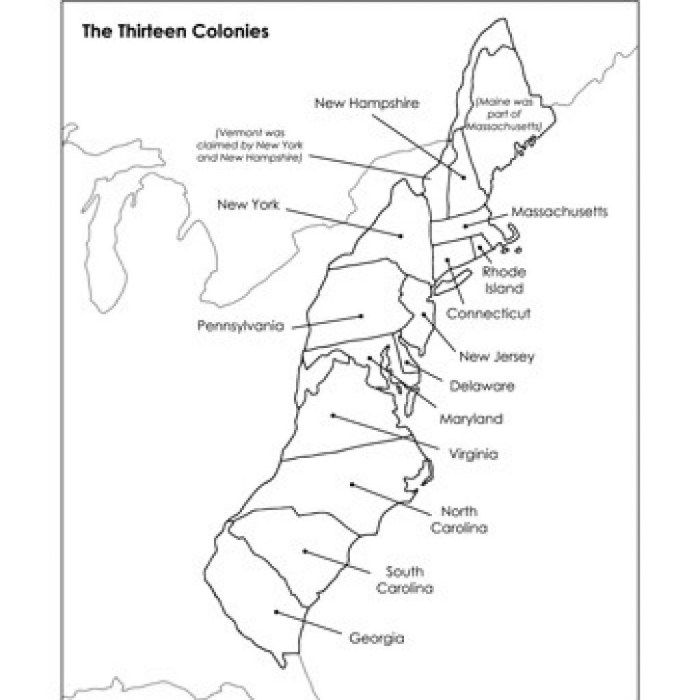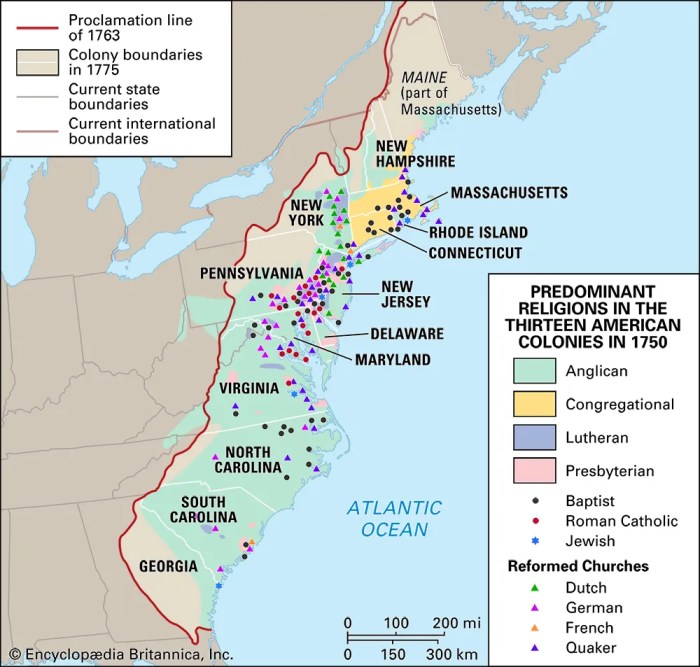Map of the 13 colonies with capitals – Delve into the intriguing history of the 13 American colonies with our meticulously crafted map, providing an unparalleled visual representation of their capitals and the pivotal role they played in shaping the nation’s destiny.
Through this interactive guide, you will embark on a journey through time, exploring the geographical and political landscape of colonial America, uncovering the significance of each colony’s capital and the fascinating stories they hold.
Historical Context

The 13 colonies, established along the Atlantic coast of North America during the 17th and 18th centuries, played a pivotal role in the founding of the United States of America. These colonies, each with its own unique history and characteristics, formed the nucleus of the American Revolution and the subsequent establishment of an independent nation.
Maps, as visual representations of geographical and political landscapes, served as invaluable tools for understanding the colonial era. They provided a comprehensive view of the colonies’ locations, boundaries, and relationships to one another, aiding in strategic planning, economic development, and political decision-making.
Map Analysis
The map of the 13 colonies serves as a visual representation of the geographical and political landscape of the British colonies in North America during the 18th century. It showcases the 13 individual colonies, each with its own capital, along with prominent geographical features and settlements.
The map is designed to provide a comprehensive overview of the colonies’ locations, boundaries, and key landmarks. It employs various colors and symbols to differentiate between the colonies, highlight significant cities, and indicate geographical features such as rivers, mountains, and coastlines.
Geographical Features
The map incorporates key geographical features that influenced the development and interactions of the 13 colonies. These features include:
- Rivers:Major rivers such as the Hudson, Delaware, Potomac, and Mississippi served as transportation routes, boundaries, and sources of water and power.
- Mountains:The Appalachian Mountains formed a natural barrier between the coastal colonies and the western frontier, influencing settlement patterns and trade routes.
- Coastlines:The Atlantic coastline provided access to trade, fishing, and shipbuilding, shaping the economies and cultures of the coastal colonies.
Capitals and Governance: Map Of The 13 Colonies With Capitals

The thirteen American colonies, each with its own unique capital, played a significant role in the governance and administration of the colonial territories. These capitals served as centers of political, economic, and social life, shaping the development of the colonies and laying the foundation for the United States.
The establishment of colonial capitals was often driven by strategic considerations, such as proximity to major waterways or access to natural resources. Over time, these capitals evolved into thriving urban centers, attracting merchants, artisans, and other settlers.
Capitals and their Significance
| Colony | Capital | Founding Date | Historical Significance |
|---|---|---|---|
| Connecticut | Hartford | 1636 | Served as the seat of the Connecticut General Assembly and a major center of trade and commerce. |
| Delaware | New Castle | 1651 | Was the first permanent European settlement in Delaware and a strategic location for trade and defense. |
| Georgia | Savannah | 1733 | Founded by James Oglethorpe as a refuge for debtors and persecuted Protestants, it became a major port city. |
| Maryland | Annapolis | 1695 | Named after Queen Anne, it served as the political and economic center of Maryland and was home to the Maryland State House. |
| Massachusetts | Boston | 1630 | A major center of commerce, shipbuilding, and intellectual activity, it played a pivotal role in the American Revolution. |
| New Hampshire | Portsmouth | 1623 | Founded as a fishing and trading settlement, it became a major shipbuilding center and a center of maritime commerce. |
| New Jersey | Perth Amboy | 1683 | One of the two original capitals of New Jersey, it was a major port and commercial center. |
| New York | New York City | 1624 | Founded as New Amsterdam by the Dutch, it became a major port and commercial hub, and later the capital of the United States. |
| North Carolina | New Bern | 1710 | Served as the political and economic center of North Carolina and was a major port for trade and commerce. |
| Pennsylvania | Philadelphia | 1682 | Founded by William Penn as a Quaker settlement, it became a major center of commerce, culture, and intellectual activity. |
| Rhode Island | Newport | 1639 | A major center of commerce and shipbuilding, it played a significant role in the American Revolution. |
| South Carolina | Charleston | 1670 | Founded as Charles Town, it became a major port and commercial center, and played a pivotal role in the American Revolution. |
| Virginia | Williamsburg | 1699 | Served as the political and economic center of Virginia and was home to the College of William & Mary. |
Colonial Boundaries and Disputes

The boundaries of the 13 colonies were defined by royal charters, treaties, and wars. These boundaries were often disputed, leading to conflicts between colonies and Native American tribes.
One of the most common causes of boundary disputes was land claims. Colonies often claimed land that was already occupied by Native American tribes. This led to conflicts, as the tribes resisted the colonists’ attempts to settle on their land.
Another factor that influenced boundary disputes was natural resources. Colonies often competed for control of resources such as land, water, and minerals. This competition led to conflicts, as colonies tried to secure access to these resources.
Political ambitions also played a role in boundary disputes. Some colonies wanted to expand their territory, while others wanted to protect their existing borders. This led to conflicts, as colonies tried to gain or maintain control of land.
New England Colonies
The New England colonies had relatively few boundary disputes. The colonies were founded by Puritans who were seeking religious freedom. They were not interested in expanding their territory, and they were willing to negotiate with Native American tribes.
Middle Colonies
The Middle colonies had more boundary disputes than the New England colonies. The colonies were founded by a variety of groups, including Dutch, English, and Germans. These groups had different interests, and they often competed for control of land.
Southern Colonies, Map of the 13 colonies with capitals
The Southern colonies had the most boundary disputes. The colonies were founded by English settlers who were interested in expanding their territory. They were not willing to negotiate with Native American tribes, and they often used force to take land.
Transportation and Trade Routes

Transportation and trade routes played a pivotal role in the economic development and communication within the 13 colonies. These routes facilitated the exchange of goods, ideas, and people, fostering a sense of unity and interdependence among the colonies.
The major transportation routes included:
- The Atlantic Ocean: The Atlantic Ocean served as a vital waterway, connecting the colonies to Europe, the Caribbean, and other parts of the world.
- The Hudson River: The Hudson River provided a natural waterway connecting New York City to the interior of the colony.
- The Delaware River: The Delaware River connected Philadelphia to the interior of Pennsylvania and New Jersey.
- The Chesapeake Bay: The Chesapeake Bay provided a waterway for trade and transportation between Maryland and Virginia.
- The Great Wagon Road: The Great Wagon Road was a major overland route that connected Pennsylvania to the Ohio River Valley.
These routes facilitated the transportation of agricultural products, raw materials, and manufactured goods between the colonies and other parts of the world. The exchange of goods stimulated economic growth and specialization within the colonies.
In addition to trade, these routes also played a crucial role in communication and the spread of ideas. The exchange of newspapers, books, and letters helped to foster a sense of common identity and shared experiences among the colonists.
Regional Differences and Similarities

The 13 colonies exhibited a mosaic of regional differences and similarities, shaped by a confluence of factors including geography, immigration patterns, and religious beliefs.These variations manifested in their economies, cultures, and political systems. The northern colonies, comprising New England, were characterized by a rocky coastline, small farms, and a thriving maritime trade.
Their economies relied heavily on fishing, shipbuilding, and commerce, while their societies were influenced by Puritanism, fostering a strong work ethic and a focus on education.In contrast, the southern colonies, stretching from Virginia to Georgia, possessed vast plantations, a warm climate, and a plantation-based economy centered on cash crops such as tobacco, rice, and indigo.
Their societies were hierarchical, with a planter elite dominating the political and economic landscape.The middle colonies, encompassing New York, New Jersey, Pennsylvania, and Delaware, served as a bridge between the north and the south. Their diverse populations, including Dutch, German, and Quaker settlers, contributed to a more pluralistic and tolerant atmosphere.
Their economies were a blend of agriculture, commerce, and industry.Despite these regional differences, the 13 colonies shared certain commonalities. They all recognized the British monarchy and were subject to British laws and regulations. Additionally, they shared a common language, English, and a Protestant religious heritage.
These shared traits fostered a sense of unity and laid the foundation for the eventual formation of the United States of America.
Question & Answer Hub
What were the major transportation routes connecting the 13 colonies?
Major transportation routes included the Atlantic Ocean coastline, the Mississippi River, and established roads and trails, such as the King’s Highway and the Great Wagon Road.
How did regional differences influence the development of the 13 colonies?
Geography, immigration patterns, and religious beliefs contributed to regional variations in economies, cultures, and political systems among the 13 colonies.



